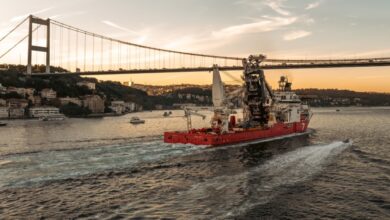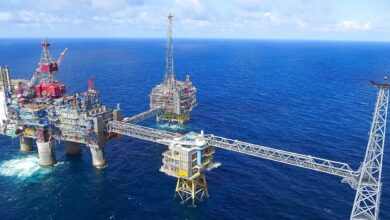Chevron to renew push for dual-gradient
 Chevron is getting back into the dual-gradient drilling business. Seen a decade ago as an enormous enabler to deepwater drilling by minimizing the number of casing strings, numerous dual-gradient solutions were attempted in the late 1990s, only to be abandoned as oil prices collapsed amid daunting technical challenges.
Chevron is getting back into the dual-gradient drilling business. Seen a decade ago as an enormous enabler to deepwater drilling by minimizing the number of casing strings, numerous dual-gradient solutions were attempted in the late 1990s, only to be abandoned as oil prices collapsed amid daunting technical challenges.
Now that may be changing. Chevron is reinvigorating the effort and says it is reviewing the technology for possible installation on one of its deepwater rigs.
The idea of a dual-gradient system dates to the 1960s. While “dual gradient” implies any system containing two different fluids, it is generally meant to indicate a well with seawater above the sea floor, and mud below. This allows the slope of the depth-vs-pressure curve of the mud-filled well section to roughly parallel that of the pore pressure/fracture gradient curves.
This means a simpler well design. In conventional approaches with a single gradient fluid, the curve falls well outside the pore/fracture pressure “window,” requiring many more casing strings. And, the more pipe in the hole, the more telescoping that will occur, diminishing the size of the final hole at TD.
Essentially, dual gradient changes the physics so that the well thinks the rig sits on the sea floor.
“It will be a real game changer,” said David Dowell, senior drilling advisor, Chevron, speaking at the 2009 Drilling Engineering Association Workshop, held 19 August in Houston. “It will let us do things that we now can’t realistically do.”
Dual-gradient should also reduce nonproductive time related to ballooning, as well as enable sidetracking.

Dual-gradient wells have seawater above the sea floor and mud below it, allowing the slope of the depth-vs-pressure curve of the mud-filled well section to roughly parallel that of the pore pressure/fracture gradient curves. (Source: Chevron)
The system uses a sea-floor subsea rotating device (SRD), a line that supplies power to the mudlift pump and a mud-return line back to the rig. A drillstring valve prevents mud from u-tubing out of the drillstring.
Mr Dowell said that Chevron’s early work with dual gradient achieved 90% of its objectives when it was prototype tested in 2001. The field test was the final phase of a major industry JIP consisting of 8 companies (4 operators). The tests were conducted using Diamond Offshore Drilling’s semi Ocean New Era on Chevron’s Shasta Prospect.
The major obstacles to dual gradient moving forward in 2001 included a perception of high risk, need for multi-year commitment, need for newbuild rigs (which have been ordered over the past 2-3 years), and lack of an appropriate deepwater portfolio.
But those obstacles have largely been swept away since 2001-2002. If successful, this enabler could greatly slash costs for complex, deepwater wells.




